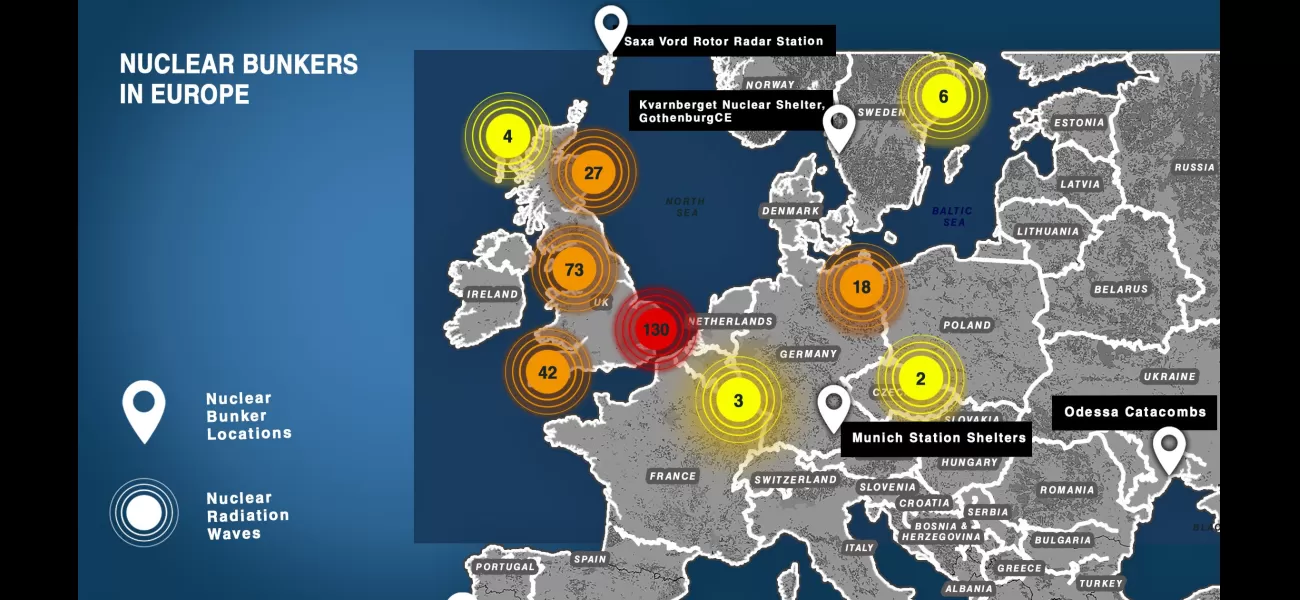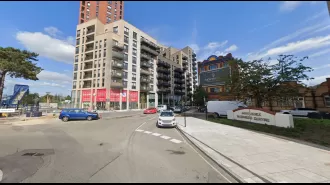Map shows Europe's nations with the highest number of nuclear bunkers.
Europe is facing the highest risk of nuclear war since the Cold War.
June 7th 2024.

In light of Vladimir Putin's actions in Ukraine, there has been a heightened awareness of the network of nuclear bunkers scattered across Europe. Images of Ukrainian citizens seeking refuge in Kyiv's metro stations have caused other Europeans to contemplate where they would go in the event of another war. This is the first time since the Cold War that the threat of a nuclear explosion on European soil has felt so imminent.
In response to the current geopolitical climate, some of the world's wealthiest individuals have invested in their own personal bunkers, similar to the one featured in the Netflix movie "Leave the World Behind". Even celebrities like Mark Zuckerberg, Kim Kardashian, Shaquille O'Neal, and Tom Cruise are rumored to have their own shelters or safe rooms. It's even been speculated that Bill Gates has bunkers under each of his homes. But what about the rest of us? Where can we turn to for protection?
According to Subterranea Britannica, The Agency has created a map that pinpoints the locations of some of the nuclear bunkers in Europe. Of course, no one hopes to ever have to use these shelters, but it's comforting to know that they are there. In the UK alone, there are 276 bunkers, most of which were built during the Cold War era as tensions between the US, NATO, and the Soviet Union ran high. London, being a major city, has 14 bunkers within its center and a total of 47 in the Greater London area.
Other major cities in the UK, such as Birmingham, Manchester, Liverpool, and Preston, also have a significant number of bunkers. Scotland has a total of 10 bunkers, with 7 in Edinburgh and 3 just outside of Glasgow. And while Wales has 11 bunkers, Northern Ireland only has 3. Subterranea Britannica also provides information on the current state of these bunkers.
Experts have warned that London needs to be better prepared in case of a wider conflict in Europe, as it would surely be a target for Putin. Nick Cooper, author of "London Underground at War", suggests seeking shelter in Hampstead station, which runs 58.5 meters below ground. To learn more about evacuations and rationing in the event of another war, you can read Brooke's investigation here.
Moving on to other countries in Europe, Germany has a total of 19 bunkers, with most of them located in and around Berlin. Munich Central Station is also home to two civilian shelters that can hold over 3,000 people. After the war, one of these shelters was used as housing for immigrant workers, earning the area the nickname "Little Italy". Sweden, known for its thorough civil defense approach, has constructed a vast network of bunkers, with 5 in Stockholm and 2 in Härnösand. The largest of these is Katarinaberget, which can accommodate up to 20,000 people and has bunks for 5,000 spread across 3 floors.
Even Czechia has its own nuclear bunker, located beneath Hotel Jalta in Prague. This facility, with walls 3 meters thick, can house around 150 people and has an emergency exit ladder that emerges in front of the hotel. There is also a second shelter near the border with Poland.
In conclusion, while it's not a pleasant thought, it's important to know where to seek shelter in case of a nuclear war. The network of bunkers across Europe serves as a reminder of the potential dangers we face, but also provides a sense of security and preparedness. Let's hope we never have to use them.
In response to the current geopolitical climate, some of the world's wealthiest individuals have invested in their own personal bunkers, similar to the one featured in the Netflix movie "Leave the World Behind". Even celebrities like Mark Zuckerberg, Kim Kardashian, Shaquille O'Neal, and Tom Cruise are rumored to have their own shelters or safe rooms. It's even been speculated that Bill Gates has bunkers under each of his homes. But what about the rest of us? Where can we turn to for protection?
According to Subterranea Britannica, The Agency has created a map that pinpoints the locations of some of the nuclear bunkers in Europe. Of course, no one hopes to ever have to use these shelters, but it's comforting to know that they are there. In the UK alone, there are 276 bunkers, most of which were built during the Cold War era as tensions between the US, NATO, and the Soviet Union ran high. London, being a major city, has 14 bunkers within its center and a total of 47 in the Greater London area.
Other major cities in the UK, such as Birmingham, Manchester, Liverpool, and Preston, also have a significant number of bunkers. Scotland has a total of 10 bunkers, with 7 in Edinburgh and 3 just outside of Glasgow. And while Wales has 11 bunkers, Northern Ireland only has 3. Subterranea Britannica also provides information on the current state of these bunkers.
Experts have warned that London needs to be better prepared in case of a wider conflict in Europe, as it would surely be a target for Putin. Nick Cooper, author of "London Underground at War", suggests seeking shelter in Hampstead station, which runs 58.5 meters below ground. To learn more about evacuations and rationing in the event of another war, you can read Brooke's investigation here.
Moving on to other countries in Europe, Germany has a total of 19 bunkers, with most of them located in and around Berlin. Munich Central Station is also home to two civilian shelters that can hold over 3,000 people. After the war, one of these shelters was used as housing for immigrant workers, earning the area the nickname "Little Italy". Sweden, known for its thorough civil defense approach, has constructed a vast network of bunkers, with 5 in Stockholm and 2 in Härnösand. The largest of these is Katarinaberget, which can accommodate up to 20,000 people and has bunks for 5,000 spread across 3 floors.
Even Czechia has its own nuclear bunker, located beneath Hotel Jalta in Prague. This facility, with walls 3 meters thick, can house around 150 people and has an emergency exit ladder that emerges in front of the hotel. There is also a second shelter near the border with Poland.
In conclusion, while it's not a pleasant thought, it's important to know where to seek shelter in case of a nuclear war. The network of bunkers across Europe serves as a reminder of the potential dangers we face, but also provides a sense of security and preparedness. Let's hope we never have to use them.
[This article has been trending online recently and has been generated with AI. Your feed is customized.]
[Generative AI is experimental.]
0
0
Submit Comment





